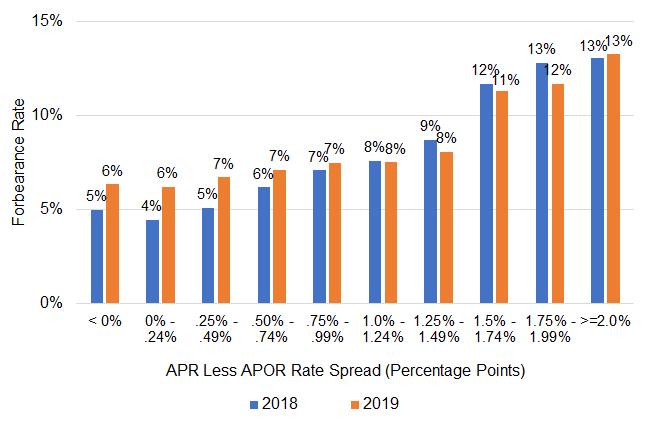Higher-Priced Mortgage Loans Are at More Risk when COVID-19 Forbearance Ends
As the COVID-19 global pandemic has created a havoc in the global economy, millions of American homeowners are struggling to keep up with their mortgage payments. As of December 1, MBA data showed about 2.8 million homeowners are in a forbearance plan. Congress enacted the CARES Act to provide consumer protections and it includes an option for homeowners to request a pause or reduction in mortgage payments, i.e. forbearance, for up to 360 days.[1]
This blog examines the forbearance rate by APR (Annual Percentage Rate) and Average Prime Offer Rate (APOR) spread for all conventional loans. APOR is a weekly market index of the average loan APRs offered by a selection of lenders across several mortgage products. The difference between a loan’s APR and the APOR is referred to as the “rate spread.” In general, loans with a rate spread of 1.5 percentage points or more are considered higher-priced loans.
The data shows that the forbearance rates are higher for higher-priced loans.[2] As forbearance and delinquency are highly correlated, the finding is consistent with our prior analysis. Our previous analysis had shown that loan delinquency increased as rate spread increased. Figure 1 displays forbearance rates for conventional loans for vintage years 2018-2019. However, not all forbearance loans are in some form of delinquency. About 30% of the homeowners with conventional loans in active forbearance plans in October were current in their mortgage payments. Some homeowners may have applied for forbearance in case their financial hardship worsened even though they were able to remain current in their payments.
The forbearance rates in the figure are displayed by rate spread category, in increments of 0.25 percentage points. Figure 1 shows that the forbearance rate was lowest for loans with a rate spread of 0-0.25% and highest for the loans with rate spreads above 2%, based on servicing data through October 2020. There were notable increases in forbearance as rate spreads increased. Especially, the variation in forbearance rates is depicted between the loans with 1.25% – 1.49% and 1.50% – 1.74% rate spread categories. The forbearance rate for loans with 1.50% – 1.74% rate spread is higher by 3 percentage points than the loans with 1.25% – 1.49% rate spread.
Higher-priced loans were more likely to experience forbearance than lower rate spread loans in this analysis. As borrowers come to the end of their CARES Act forbearance period, barring any further government programs or economic stimulus, there is a risk of an increase in mortgage foreclosures, especially among borrowers who remain in financial hardship and have little or no home equity.

©2020 CoreLogic, Inc. All rights reserved.
[1] The CARES Act forbearance provisions cover the federally backed mortgage lending programs (Fannie Mae, Freddie Mac, FHA, VA, RHS). A borrower with a federally backed mortgage loan experiencing a financial hardship due to the COVID–19 emergency may request forbearance; forbearance shall be granted for up to 180 days, and shall be extended for an additional period of up to 180 days at the request of the borrower. Homeowner’s credit score will not be impacted during the forbearance period despite the missed/late payments.
[2] CoreLogic Loan-Level Market Analytics (LLMA) data was merged with 2018-2019 HMDA data by employing a unique matching technique that linked LLMA loan performance data to HMDA origination data. The match was based on loan characteristics, such as the loan amount, the loan purpose, the loan type, census tract, origination year, and the lender identity key. The overall match rate was about 50% of the LLMA data. Forbearance status of loans were tracked up to the month of October. We include both purchase and refinance loans in our analysis to provide a comprehensive review. Rate spread below 1.5% was not provided in HMDA data prior to 2018. Thus, we just include loans originated in 2018-2019.

